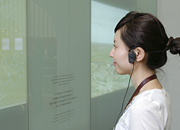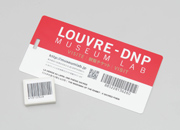|
|
 |
 |
 |
 |
 |
| For this fourth presentation, we combined printing and projection, exploiting the advantages of both technologies: printing for the accurate reproduction of curves (writing or drawing on a map), and the projection of animations for the faithful reproduction of degrees of color and movement. The animations illustrate the printed maps and follow the thread of the audio commentary. This new mode of expression, which aids visual comprehension, is tested in the following two ways. |
 |
 |
 |
| This is a dynamic mode of visual expression that can be used on a large scale, allowing us to use the whole wall surface as a screen. |
 |
 |
|
 |
 |
 |
| This allows us to display high-quality images with reduced luminosity and thereby avoid the drawbacks of images on a screen. |
 |
 |
|
 |
 |
 |
A Plexiglas scale model is turned into a projection screen. A device using two projectors - which can be manipulated by several users at the same time - projects information of all kinds at various spots.
The computer presence is forgotten thanks to this interactive map, which facilitates an intuitive understanding of the information provided. |
 |
 |
|
 |
 |
 |
| "Augmented reality" is a technology that makes it possible to obtain far more information about an object or a scene than can be obtained by simply looking. Texts, images, or videos can be added to the real scene or target object before the spectator's eyes through superimposition, and by means of a screen. This highly promising technology makes it possible, in the field of architecture for example, to test the successful integration of a planned building into its future real environment. In industry, it can be used as an "instruction manual" to facilitate assembly operations. At Museum Lab, we are exploring its potential uses to assist visitors within the presentation area by giving directions or providing explanations about an exhibit. |
 |
 |
|
 |
 |
 |
First of all, the object or scene and the information intended to accompany it are computerized. The computer performs a real-time analysis of the images filmed by a camera. It selects the information that needs to be added to the filmed image, and produces 3D digital images which are combined with the filmed material. The result is merged into a single image and displayed on the screen. The specificity of this technology is the real-time processing of the 2-D images of the camera to blend them with 3-D digital images.
This device was designed so that, by means of a sensor that recognizes the direction and angle of the camera, the resulting images are always stable. The 3-D digital images are overlaid on the image of the object on the screen. When the object moves, the images follow. The guidance system devised for this fourth presentation provides the visitor with a mini-computer. The visitor moves around the presentation area; according to the route he or she takes, digital images are produced in real time by recognition of elements in the real world - "target objects" such as posters or signs displayed in the presentation space.
This application is an improved version of the AR technology known to date, and has prompted considerable interest in many different fields. |
 |
 |
 |
 |
 |
| The audioguide available at Museum Lab proposes a commentary that is automatically generated, allowing visitors to concentrate on the exhibits and multimedia contents. Thanks to a bone conduction headset, visitors can listen to the guide and talk to the people around them at the same time. |
 |
 |
|
 |
 |
 |
| The Museum Lab guidance system uses RFID electronic tag technology, which makes it possible to identify each visitor and satisfy individual needs: listening to a commentary in a specific language, keeping a record of an individual visit. When a visitor is detected in front of a device, a server identifies (in real time) the language he or she selected at the reception desk, and simultaneously generates a commentary in the appropriate language. Moreover, information concerning individual visits is also processed by the server thanks to the electronic ticket. Visitors can therefore view a record of their visits on "My Museum Lab", the Museum Lab members'site. |
 |
 |
|
|
|
|
 |